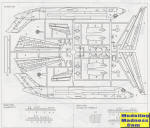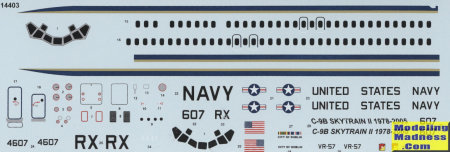
| KIT #: | 14403 |
| PRICE: | $20.00 'used' |
| DECALS: | One option |
| REVIEWER: | Scott Van Aken |
| NOTES: | Short run kit with resin parts |

| HISTORY |
The McDonnell Douglas C-9 was a military version of the McDonnell Douglas DC-9 airliner. It was produced as the C-9A Nightingale for the United States Air Force, and the C-9B Skytrain II for the U.S. Navy and Marine Corps. The final flight of the C-9A Nightingale was in September 2005, and the C-9C was retired in September 2011. The U.S. Navy retired its last C-9B in July 2014. The two remaining C-9s in Marine service were retired in April 2017.
After selecting a modified DC-9 for passenger and cargo transport, the U.S. Navy ordered its first five C-9Bs, bureau numbers 159030 thru 159034 in April 1972. However, since the Air Force in the early 1970s, under the Military Airlift Command, was responsible for moving military personnel from place to place this order was canceled.
The Navy documented to Congress that their people were being given last seating on Air Force flights. Congress authorized the Navy to fly its own passenger/cargo jets shortly thereafter. The Navy ordered eight aircraft, bureau numbers 159113 thru 159120. The first four went to VR-30 at NAS Alameda in California for west coast logistical support while the second four went to VR-1 at Norfolk in Virginia for east coast support. An additional six aircraft, bureau numbers 160046 through 160051 were delivered to the Navy and the Marine Corp in 1976 with the first two aircraft being delivered to the Marine Corp at MCAS Cherry Point, the second two delivered to VR-1 at NAS Norfolk and the last two delivered to VR-30 at NAS Alameda. An additional ten more new and ten used DC-9s were purchased and converted to C-9B for the Navy. The last C-9B to fly for the Navy was retired on 28 June 2014.The C-9B aircraft have provided cargo and passenger transportation as well as forward deployed air logistics support for the Navy and Marine Corps. (The original "Skytrain" was the World War II era C-47 developed from the civilian DC-3.) A C-9B was also chosen by NASA for reduced gravity research, replacing the aging KC-135 Vomit Comet.
Many of the Navy's C-9Bs had a higher maximum gross take-off weight of 110,000 lb (50,000 kg). Auxiliary fuel tanks were installed in the lower cargo hold to augment the aircraft's range to nearly 2,600 nautical miles (4,800 km) for overseas missions.
| THE KIT |
 If
you have ever built the Airfix DC-9, then this kit will look familiar. It is
NOT the Airfix kit reboxed, but the parts layout is very similar. Fly uses
this base kit for a number of DC-9 variants and will often provide
additional fuselage halves for the stretched variants. As is the norm with
short run kits, you will have to remove the ejector towers from some of the
large parts in order to assemble them.
If
you have ever built the Airfix DC-9, then this kit will look familiar. It is
NOT the Airfix kit reboxed, but the parts layout is very similar. Fly uses
this base kit for a number of DC-9 variants and will often provide
additional fuselage halves for the stretched variants. As is the norm with
short run kits, you will have to remove the ejector towers from some of the
large parts in order to assemble them.
There are no clear parts and the fuselage halves are smooth. Nose weight is required, but how much is not specified. Engine nacelles are right and left halves with first and last compressor sections. The wings are upper and lower halves with all the flap actuator parts being separate. The inner gear doors are molded shut as they'd normally be on the ground. Landing gear is fairly well done and some will find their fairly small size to be an issue when it comes to painting the model .
Instructions are generic DC-9 and usable
on all of their various boxings. The kit provides sprues of antennas in
resin and you will pick and choose wha t
is to be installed on your model. I like this as it provides spares for
other airliner kits. There is one markings option and that is the box art
plane from VR-57 with retirement markings on the fuselage. Decals are very
nicely done and should provide no issues.
t
is to be installed on your model. I like this as it provides spares for
other airliner kits. There is one markings option and that is the box art
plane from VR-57 with retirement markings on the fuselage. Decals are very
nicely done and should provide no issues.
 Now, I will advise any builder
to get a photo of this plane as a full side view. I joined VR-30 in 1976
when these planes were still new. Our planes were DC-9-32CF versions with a
cargo door on the left forward side. The decal sheet does not provide this,
though it does provide the standard baggage doors. The kit also does not
provide the crash position indicator that were on our C-9Bs. This was a
square fairing added to the aft portion of the fin and was easily seen as a
red square on the right side of the plane. I have included a photo to show
you what that looked like. Should also mention that it is quite probable
that the later planes, which were converted from airliners, did not have had
this feature installed so check your reference photos. Caracal makes a nice
C-9 sheet that could also be used.
Now, I will advise any builder
to get a photo of this plane as a full side view. I joined VR-30 in 1976
when these planes were still new. Our planes were DC-9-32CF versions with a
cargo door on the left forward side. The decal sheet does not provide this,
though it does provide the standard baggage doors. The kit also does not
provide the crash position indicator that were on our C-9Bs. This was a
square fairing added to the aft portion of the fin and was easily seen as a
red square on the right side of the plane. I have included a photo to show
you what that looked like. Should also mention that it is quite probable
that the later planes, which were converted from airliners, did not have had
this feature installed so check your reference photos. Caracal makes a nice
C-9 sheet that could also be used.
| CONCLUSIONS |
This will not be a difficult kit to build. The parts count is fairly low and you'll undoubtedly be spending most of your time painting and masking.
| REFERENCES |
https://en.wikipedia.org/wiki/McDonnell_Douglas_C-9
August 2020
Copyright ModelingMadness.com. All rights reserved.
Thanks to
for the preview kit. You can find this kit at your favorite hobby shop
or on-line retailer.
If you would like your product reviewed fairly and fairly quickly, please
contact the editor or see other details in the
Note to
Contributors. Back to the Main Page
Back to the Review Index Page
Back to the Previews Index Page